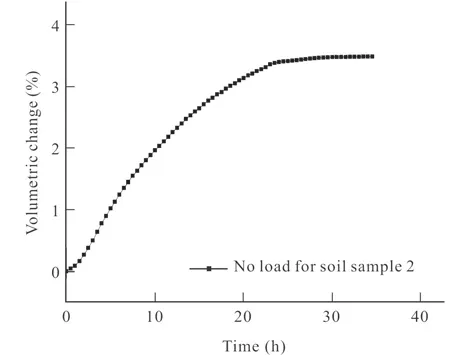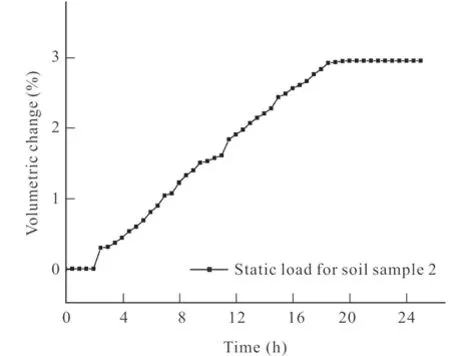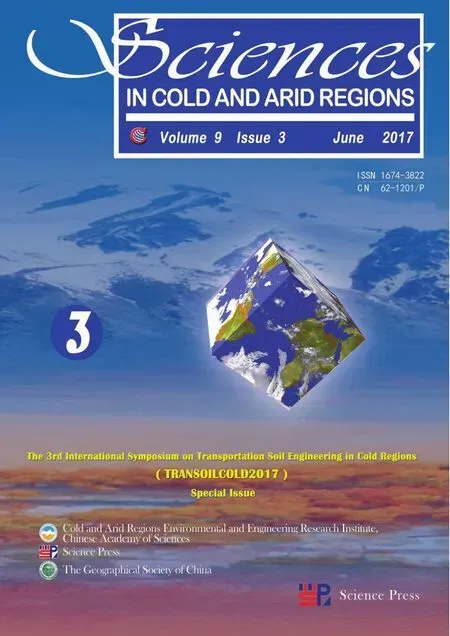Deformation properties of chloride saline soil under actionofalow-temperatureenvironmentanddifferentloads
Yu Zhang,JianKun Liu,JianHong Fang,AnHua Xu
1.Lanzhou Jiaotong University,School of Traffic and Transportation,Lanzhou,Gansu 730070,China
2.Beijing Jiaotong University,School of Civil Engineering,Beijing 100044,China
3.Qinghai Research Institute of Transportation,Xining,Qinghai 810001,China
Deformation properties of chloride saline soil under actionofalow-temperatureenvironmentanddifferentloads
Yu Zhang1*,JianKun Liu2,JianHong Fang3,AnHua Xu3
1.Lanzhou Jiaotong University,School of Traffic and Transportation,Lanzhou,Gansu 730070,China
2.Beijing Jiaotong University,School of Civil Engineering,Beijing 100044,China
3.Qinghai Research Institute of Transportation,Xining,Qinghai 810001,China
To find the deformation properties of chloride saline soil under the influence of a low temperature environment and different loads,two types of chloride saline soil were selected and their deformation process was tested in the laboratory and analyzed during the cooling process in the sensitive cryogenic temperature range.The research results show that high-chloride-salt saline soil underwent little volume change under the no-load condition during the cooling process.Under staticload and dynamic-load conditions,different degrees of settlement deformation occurred;throughout the entire cooling process,another chloride saline soil with a high proportion of sulfate salt underwent volume expansion under no-load and static-load conditions.Under the no-load condition,a certain degree of settlement deformation occurred.Deformation properties were evaluated at different time points during the cooling process for two kinds of chloride saline soil.Finally, deformation characteristics of chloride saline soil were analyzed from the perspective of salt type and crystallization variation under the action of a low-temperature environment and different loads.
saline soil;low temperature;loads;deformation;cooling process
1 Introduction
Due to differences in temperature,moisture,salt type,salt content,and other cooling conditions,different strengths and deformations of saline soil occur. With the developing construction in northwestern China,it becomes urgent to study the deformation characteristics of saline soil at low temperature,which can provide theoretical guidance for construction in saline soil regions.
Few studies have been reported on the deformation properties of chloride saline soils under low temperature and different loads.In the study of heavy saline soil,unconfined strength change was evaluated during repeated temperature raising(Chenet al., 1988).After experiencing freeze-thaw cycles of different durations at room temperature,soils with different sodium sulfate and water content were subjected to uniaxial compressive strength tests to derive a saline soil stress-strain curve and showed brittle fracture (Bing and He,2009).The salt-expansion laws of crude saline soil were tested by subjecting representative saline soil samples from twelve places(Kashi,Sinkiang,China)to freezing and thawing cycles in the laboratory at room temperature(Baoet al.,2006).The creep behavior of saline ice and frozen saline sand indicated that,under the same load conditions,the time to failure of the two materials varies greatly;however,when the strain is less than 2%,the creep properties are very similar(Pharr and Godavarti,1987).Three different salts(NaCl,MgSO4,and Na2SO4) have impacts on soil-creep deformation(Roman and Alifanova,1993).Saline soil's cohesion is affected by freezing and thawing cycles at room temperature (Chenet al.,2007).
There were many previous studies on strength and deformation in uniaxial and multiaxial compressive strength tests,shear-strength tests,and strength tests under freezing and thawing cycles for sulfate-salt saline soils.All these tests were carried out at room temperature,with few experimental results reported on the deformation of chloride-salt saline soil at low temperature.
In the study described in this paper,embankmentfilling deformations of chloride-salt saline soil were tested in the lab under low-temperature and different loads.The deformation properties of chloride saline soil are discussed for different time points during the cooling process.
2 Experiment equipment
In the experiment,a walk-in cryostat chamber, cryostat cycle equipment,and loading equipment were used.The size of the walk-in cryostat chamber is 3m× 3m×2m(length×width×height),and its minimum control temperature of low temperature was−22°C, and the temperature chosen for the study was−20°C. The chamber is thermostatically controlled by a computerized,externally visible control box and internal ventilation-cooling equipment.During the experiment,the temperature of the walk-in cryostat chamber can stabilize at a set temperature within±0.5°C.
The minimum temperature limit of cryostat cycle equipment is−30°C.During the experiment,temperaturecanstabilizeatthe settemperaturewithin±0.1°C.
Loading equipment can provide different loading methods,such as static loads and dynamic loads.Static loads range from 0 kPa to 60 kPa and change with different frequencies and different types of wave.
3 Experiment
3.1 The basic parameters of soil samples
Two kinds of saline soil samples from Qarhan of Qinghai Province were selected for testing,and the basic physical properties test and soluble-salt chemical test were carried out(Test methods of soils for highway engineering in China(JTG E40-2007),2007). The basic parameters of the soil samples are shown in Tables 1 and 2,with two kinds of soil samples being low-liquid-limit clay.The soil samples were numbered, and the salt in the soil sample 1 was mainly chloride salt,with a high total salt content;while sample 2 had a relatively high sulfate-salt content.

Table 1 Main parameters of the tested saline soils

Table 2 Ion content of the tested saline soils
3.2 Soil sample preparation and test design
The embankment-filling deformation test was simulated under low temperature and different loads.The test equipment is shown in Figure 1,and specific test procedures are as follows:
(1)First,we chose a plexiglass cylinder with a diameter of 150 mm and a wall thickness of 10 mm. Then,a thin layer of petroleum jelly was smeared evenly onto the inside wall of cylinder,and plastic film was pasted along the inside wall of cylinder to ensure that the outside water cannot enter during the test.The plexiglass cylinder and its supporting base plate were combined.The soil was divided into five layers and put into the plexiglass cylinder,and each layer was compacted according to the requirements. The control height of each layer was 20 mm.The surface of each layer was shaved to rough the surface after each layer was compacted,and then the next layer was inserted and compacted.At last,we put filter paper at the upper and lower ends of the soil sample to provide a permeable airtight seal.
(2)After the soil samples were prepared,the top plate was installed and the temperature sensors inserted into the temperature holes.From top to bottom of the cylinder,a temperature sensor was inserted every 2 cm,and the outer wall of the cylinder was wrapped with a sponge,which provided thermal insulation. The assemblage was then put aside for 24 hours to distribute the soil moisture evenly.
(3)The temperature of the walk-in cryostat chamber was kept at 5°C and the cryostat adjusted so that the sample temperature of the top and bottom plates reached 5°C.
(4)No load,static load(30 kPa),and dynamic load (30 kPa+60 kPa)were applied to the top plate,successively.The pressure-pressuresine wavewas adjusted to the dynamic load,and its frequency set to 1 Hz.Finally, the temperature of the specimen was determined by the internalsensortobea uniform 5°Cfrom top tobottom in the cylinder.The cryostat temperature of the top platewasadjustedto−10°C,withthecryostattemperature of the bottom plate unchanged,allowing one-way cooling until the internal temperature of the soil sample reached stability.During this experiment,deformation processes of the soil samples were recorded.When the deformationreached stability,the experiment ended.

Figure 1 Test equipment
4 Test results
4.1 Deformation test of soil sample 1
The deformation-time curves for soil sample 1 under three loading conditions are shown in Figures 2, 3,and 4.
The deformation of all three loading modes showed settlement for soil sample 1,as shown in Figures 2,3,and 4.The deformation rates of the three loads(no load,static load,and dynamic load) are−0.02%,−0.16%,and−1.10%,respectively.The deformation produces little change for soil sample 1. The deformation is mainly attributed to the decreasing temperature.A salt solution in soil produces a slight volume shrinkage with decreasing temperature. Deformation mainly occurs in the initial stage of cooling and near−10°C.Soil samples 1 and 2 are unfrozen soils at−10°C(Chenet al.,2006).When the salt content reaches more than 5%and the environment temperature drops to the range of−13 to−17°C,the soil does not freeze;the volume of chlorine-salt saline soil shrinks as the temperature decreases within the range of 28°C to−17°C(Denget al.,2008).Therefore,soil sample 1 shows slight settlement deformation under low temperature and no load,with negligible deformation;the compressive deformation of the soil sample is very fast because of the external load action in the initial stage for static load.As time goes by,the deformation caused by the external load gradually weakens.Subsequent settlement deformation is also associated with decreasing temperature.The deformation in the initial stage reaches nearly 90%of the final deformation;under the dynamic-load condition,the compressive deformation of the soil sample also has a very large ratio because of the external load action in the initial stage for the static and dynamic load.However,dynamic load shows deformation throughout the entire process,as compared with the static load.Therefore,the initial deformation of soil samples is mainly caused by the combined effects of static and dynamic loads the moment the experiment begins.The deformation after that moment is mainly caused by dynamic load and decreasing temperature. So the ratio of deformation in the initial stage under dynamic load is lower than ratio of deformation in the initial stage under static load.
4.2 Deformation test of soil sample 2
The deformation-time curves for soil sample 2 under three loading conditions are shown in Figures 5, 6,and 7.
The deformation under all the three loading modes shows settlement for soil sample 2(Figures 5, 6,and 7).The deformation rates of the three loads (no load,static load,and dynamic load)are 3.47%, 2.95%,and−0.73%,respectively.The first two loading methods show salt expansion,and the latter shows settlement.Salt-expansion characteristics are obvious under first two loading methods,and the difference between the final salt-expansion rates is only about 0.5%.Deformation is mainly due to Na2SO4starting to crystallize into Na2SO4·10H2O during the cooling process.The soil expansion under static loading was only slightly smaller than that under no load. Under the dynamic load condition,the salt-expansionforce can be balanced in part of the action of dynamic loading and eventually results in a small amount of settlement.

Figure 2 Deformation vs.time for soil sample 1 under no-load condition

Figure 3 Deformation vs.time for soil sample 1 under static-load condition

Figure 4 Deformation vs.time for soil sample 1 under dynamic-load condition

Figure 5 Deformation vs.time for soil sample 2 under no-load condition

Figure 6 Deformation vs.time for soil sample 2 under static-load condition

Figure 7 Deformation vs.time for soil sample 2 under dynamic-load condition
5 Conclusions
(1)In the embankment-filling deformation test,the deformations of all the three loading modes show settlement for soil sample 1.A large proportion of the deformation occurs during the first to second hours of the initial cooling period.Deformation is mainly caused by decreasing temperature and by loading.
(2)In the cooling process,salt-expansion characteristics are obvious under no load and static load for soil sample 2.The static load has little effect on the salt expansion.Dynamic loading can effectively balance the actionof salt expansion.
Acknowledgments:
This research was supported by National Natural Science Foundation of China(No.41501062).
Bao WX,Yang XH,Xie YL,2006.Research on salt expansion of representative crude saline soil under freezing and thawing cycle.Chinese Journal of Geotechnica1 Engineering,28(11): 1991−1995.
Bing H,He P,2009.Influence of freeze-thaw cycles on physical and mechanical properties of salty soil.Chinese Journal of Geotechnica1 Engineering,31(12):1958−1962.
Chen XB,Qiu GQ,Wang YQ,et al.,1988.Heavy saline soil the physical and chemical properties and mechanical properties when the temperature changes.Chinese Science(A),4: 429−438.
Chen WT,Wang Y,Wang MN,et al.,2007.Testing study on influence of freezing and thawing circulation on saline soil's cohesion.Chinese Journal of Geotechnical Engineering,28(11): 2343−2347.
Chen XB,Liu JK,Liu HX,2006.FreezingAction of Soil and Foundation.Beijing:Chinese Science Press.
Deng YS,Pu YB,Zhou CL,2008.Experimental Study of Structure Change of Saline Soils due to Freezing.Journal of Glaciology and Geocryology,30(4):632−640.
Pharr GM,Godavarti PS,1987.A comparison of the creep behavior of saline ice and frozen saline Ottawa sand at−8°C. Cold Regions Science and Technology,14(3):273−279.DOI: 10.1016/0165-232X(87)90019-X.
Roman LT,Alifanova A,1993.Effect of salt type on deformation of frozen saline soils.Annual Report of the State Key Laboratory of Frozen Soil Engineering,3:153−158.
"Test Methods of Soils for Highway Engineering in China"(JTG E40-2007),2007.Beijing:Communications Press.
:Zhang Y,Liu JK,Fang JH,et al.,2017.Deformation properties of chloride saline soil under action of a low-temperature environment and different loads.Sciences in Cold and Arid Regions,9(3):0307-0311.
10.3724/SP.J.1226.2017.00307.
November 15,2016Accepted:December 15,2016
*Correspondence to:Yu Zhang,Ph.D.,Associate Professor of School of Traffic and Transportation,Lanzhou Jiaotong University.No.88,WestAnning Road,Lanzhou,Gansu 730070,China.E-mail:zhangyu@mail.lzjtu.cn
 Sciences in Cold and Arid Regions2017年3期
Sciences in Cold and Arid Regions2017年3期
- Sciences in Cold and Arid Regions的其它文章
- Complex analysis of the damage caused by geocryologic processes (as exemplified by effects on the Chara-China Railway track, Transbaikal region)
- Geotechnical problems on freezing ground soil and experimental investigation in Kazakhstan
- Freezing characteristics of a highway subgrade
- Technological risk regulation of the subgrade base stability in permafrost areas
- Strengthening long-term embankments maintained on permafrost soils
- Test results of railway ballast for bearing capacity calculations
